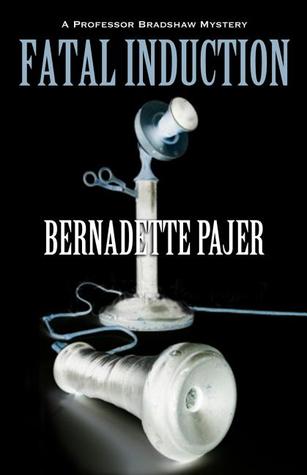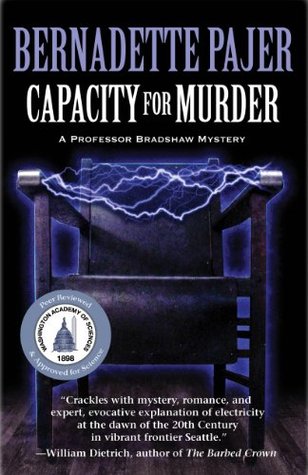Description:
Inventor Thomas Alva Edison is a ruthless businessman,intent on advancing General Electric and beating all rivals like Nikola Tesla and Westinghouse. Edison has agents in place in Seattle but he’s come himself in pursuit of a mysterious invention lost in 1901 in Elliott Bay. When Edison asks for information, few refuse. But not University of Washington Professor Benjamin Bradshaw who’s earned a reputation as a private investigator where science—electricity—is concerned. Bradshaw hopes that the lost device, one conceived in anger by an anarchist and harnessed for murder, will elude Edison’s hired divers.
Then one December morning in 1903, the Bon Marché’s Department Store electrician is found dead in the Men’s Wear Window clutching a festoon of Edison’s new holiday lights. Bradshaw believes Edison has set a dangerous game in motion. Motives multiply as the dead man’s secrets surface alongside rivalries at the Bon Marché. Bradshaw, his sleuthing partner Henry Pratt, and the Seattle PD’s Detective O’Brien pursue leads, but none spark Bradshaw’s intuition. His heart is not in the investigation but in a courtship that will force him to defy his Catholic faith or lose his beloved, Missouri. Then a crossroads in the case forces him to face his personal fears and his first professional failure. Whatever the outcomes, his life is about to change….
GUEST POST
The Do’s and Don’ts of Historical Mystery:
A Writer’s Guide and Reader’s Insight
 Immersing readers in another time is a challenge, but also a lot of fun if you enjoy doing research. If you’re writing straight historical fiction, like me, then it’s crucial to get the details right. Not only does this help you, the author, more fully immerse in your characters and setting, it also allows readers to trust you, and that makes for a more immersive experience for them. And if you’re writing historical fantasy, or alternate history, or steampunk? It’s important for the author to know the real historical facts for those, too, so that deviations from reality can be made with careful intention and with sufficient backstory so that readers accept this new world you’re creating.
Immersing readers in another time is a challenge, but also a lot of fun if you enjoy doing research. If you’re writing straight historical fiction, like me, then it’s crucial to get the details right. Not only does this help you, the author, more fully immerse in your characters and setting, it also allows readers to trust you, and that makes for a more immersive experience for them. And if you’re writing historical fantasy, or alternate history, or steampunk? It’s important for the author to know the real historical facts for those, too, so that deviations from reality can be made with careful intention and with sufficient backstory so that readers accept this new world you’re creating.
DO:
Research: The author must know far more than she puts into her stories. In order to create characters and settings that ring with authenticity, details, from the type of cloth used in a garment to the political leanings of the day, must be known and understood. Contemporary writers know these things without research, but historical writers must be time-travelers and become citizens of their story-world era.
Question everything: Double-check for accuracy and date of usage or occurrence. Beware those things you never thought to question. This is where excellent beta-readers can save you. I once had an early reader question my use of the thumb’s-up gesture in 1903. I looked into it and discovered a long and complicated history for the gesture, being negative and even obscene in some countries. In 1903 in the United States, it does not appear to have been commonly used to indicate approval, but it was used by divers to mean “time to surface” or “end the dive.”
 Weave historical detail into the story: Once you have this wealth of detail, let it become part of your characters, setting, and dialogue. Historical nuggets should be laced into the action, propelling the story forward, building visual and sensual scenes that fully immerse your reader, and yet be so integrated they do not slow the pacing.
Weave historical detail into the story: Once you have this wealth of detail, let it become part of your characters, setting, and dialogue. Historical nuggets should be laced into the action, propelling the story forward, building visual and sensual scenes that fully immerse your reader, and yet be so integrated they do not slow the pacing.
DON’T:
Assume anything: See #2 above. Write with a dictionary beside you, one that shows the date that the word came into common usage. To be certain some element you’d like to include in your story is historically accurate, search newspaper archives, if available (many are through your local library online), or use Google Books Advanced Search and set date parameters. That method has the added bonus of often uncovering rich detail as you discover magazine articles, stories, medical journals, etc. from the very date your own story is set.
Drop information bombs: See #3 above. The key is to choose nuggets from the mountains of research. Find those intimate details that have the ability to trigger full images and thoughts in readers’ minds. For example, rather than give a paragraph description of a coal stove, show your character—who is baking a poison-laced pie—shoveling in more fuel, wiping black dust onto her apron, then setting the kettle on the iron stovetop with a satisfying clang to enjoy a mug of Postum before her deadly dessert is done.
 Include historical detail not vital to the story: Oh, it’s tempting! You will discover the most fascinating detail and want to share it with your readers, but resist including details that don’t move the story forward, build or define character, or provide necessary setting information. Readers first and foremost read for STORY, and while they love to learn while they read, they don’t want to slow down for it. The Author’s Note at the end of the book is a fabulous place to share the information that didn’t quite fit the story.
Include historical detail not vital to the story: Oh, it’s tempting! You will discover the most fascinating detail and want to share it with your readers, but resist including details that don’t move the story forward, build or define character, or provide necessary setting information. Readers first and foremost read for STORY, and while they love to learn while they read, they don’t want to slow down for it. The Author’s Note at the end of the book is a fabulous place to share the information that didn’t quite fit the story.
And finally, find a system for keeping track of the research you use. I’m still working on mine. A few months from now, when you are revising a scene, you’ll likely want to check your facts or make adjustments, and being able to get your hands on that article or reference book quickly will save much time. And in a few years, when a reader emails to challenge you on a detail, you can quickly and politely quote your source. Chances are, a reader will at some point catch an error or anachronism in your work. Take a deep breath, forgive yourself for not being perfect, and kindly thank the reader for letting you know. In my experience, such readers often love the story and write because they truly care and hope to be helpful. Consider asking such readers to be beta-readers for your next manuscript. That’s how I met one of my favorite manuscript readers, who is also one of Professor Bradshaw’s biggest fans.
Goodreads ** Amazon ** Barnes&Noble ** BookDepository
About the author:
Bernadette Pajer is the author of the Professor Bradshaw Mysteries, fast-paced whodunits in the Golden-Age tradition. The books in the series have earned the Seal of Approval for Science from the Washington Academy of Sciences (established 1898.)
She's a graduate of the University of Washington and a proud member of Mystery Writers of America, Sisters in Crime, Northwest Science Writers, and the Seattle7Writers.org. Research is Pajer's favorite activity, and she happily delves into Seattle's past and the early days of electrical invention as she plots Professor Bradshaw's investigations.
Pajer lives in the Seattle area with her husband and son." (source: Amazon)


1 comment:
This is an amazing amount of research! Thanks so much for sharing how you go about turning all this data into such an enjoyable and entertaining mystery.
Post a Comment